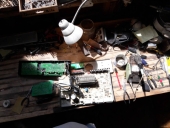I am buttoning up the lath work in preparation for custom field-mix colored cement stucco. This part of the siding project is kinda fun. A little background, my wife and I moved a 1959 pink mobile home up the hill and camped out in it around 1997. We had a little generator we could use for power once in a while, no refrigerator. We had an outhouse pretty fast. Little by little we've been building onto the trailer making it a home pay-check to pay-check. Five years ago we decided the old mobile home was finally used up and it needed to come out. In order to have a kitchen while we worked we used a Sawzal to cut end with the living-room or about a third of the trailer off and recycled the aluminium for some cash.
Two years ago before I got sick we demolished the rest of the trailer (mobile home) With the success of our earth-sheltered greenhouse we decided we'd dig the new section of the house into the hill. Just like the aquaponics greenhouse the limestone bedrock was under six inches of topsoil. I love busting rocks, but my body was going south for unknown reasons. With the help of family and friends we got the 18' x 24' building erected. During this time I had to leave my job because of illness so money got tight. For example, the roof is recycled three times tin. We were beginning to think the siding was going to stay oriented strand board (OSB) forever. I'm finally getting a handle on this autoimmune disease and I'm able to work again. Thank you great spirit in the sky!
I hope you understand from this brief introduction that we're on the bleeding edge of DIY. If resourcefulness and craftiness are the main tools in your box then please come on along and check this out, you may find it useful.
In this first image not only can you see my recycled tin roof, you can see we have the dual layer asphalt paper installed on top of inexpensive building wrap. On top of the black paper is chicken wire attached with furring nails. Furring nails have the thick paper washer to hold the wire a 1/4" away from the wall so the cement stucco can achor to it.

During a break I was watching Youtube videos about stucco to bolster what my step-son has already schooled me on. I saw all kinds of cool cement detailing being done including
curved surface cement in southeast Asia, but that was way out of my league. Then I came across someone doing some interesting stucco facade work Architectural cement plastering details on facades
architectural cement plastering on facades Wow!
I had a freeze-proof faucet that needed some help as I didn't make it stick out far enough to sit properly over the 3/4" stucco. I needed a way to be able to spin the faucet if it ever needs servicing.

First I wanted to try this sculpting technique then I added flashing to keep the area around the faucet indented.

Since the stucco is nearly an inch thick on top of this it doesn't need to be a perfect shape.
Under the paper are two half moon shaped pieces of wood screwed to the wall. They don't need much reinforcing as the lath will hold the shape. I used one by eight pine so there was enough thickness to give the roofing nails a good footing. Staple paper over the simple forms and nail lath over that. Super easy even in the tight spot I was working.
I hope between this and the video you can see how this works.
Brian

 3
3







![Filename: Faucet-fancy-cover-Stucco-lath-shadow-Sept-15-18.jpg
Description: [Thumbnail for Faucet-fancy-cover-Stucco-lath-shadow-Sept-15-18.jpg]](/t/92613/a/65079/Faucet-fancy-cover-Stucco-lath-shadow-Sept-15-18.jpg)
![Filename: Faucet-fancy-cover-Stucco-lath-2x-Sept-15-18.jpg
Description: [Thumbnail for Faucet-fancy-cover-Stucco-lath-2x-Sept-15-18.jpg]](/t/92613/a/65080/Faucet-fancy-cover-Stucco-lath-2x-Sept-15-18.jpg)
![Filename: Faucet-fancy-cover-Stucco-lath-Sept-15-18.jpg
Description: [Thumbnail for Faucet-fancy-cover-Stucco-lath-Sept-15-18.jpg]](/t/92613/a/65081/Faucet-fancy-cover-Stucco-lath-Sept-15-18.jpg)












 1
1




![Filename: Stucco-scratch-coat-Started-North-end-Kitchen-Sept-22-2018.jpg
Description: [Thumbnail for Stucco-scratch-coat-Started-North-end-Kitchen-Sept-22-2018.jpg]](/t/92613/a/65423/Stucco-scratch-coat-Started-North-end-Kitchen-Sept-22-2018.jpg)
![Filename: Stucco-scratch-coat-from-North-end-moving-along-South-Sept-22-2018.jpg
Description: [Thumbnail for Stucco-scratch-coat-from-North-end-moving-along-South-Sept-22-2018.jpg]](/t/92613/a/65424/Stucco-scratch-coat-from-North-end-moving-along-South-Sept-22-2018.jpg)
 1
1




![Filename: Second-coat-field-mix-stucco-Hobitt-hat-spigot-cover-side-Sept-2018.jpg
Description: [Thumbnail for Second-coat-field-mix-stucco-Hobitt-hat-spigot-cover-side-Sept-2018.jpg]](/t/92613/a/65453/Second-coat-field-mix-stucco-Hobitt-hat-spigot-cover-side-Sept-2018.jpg)















